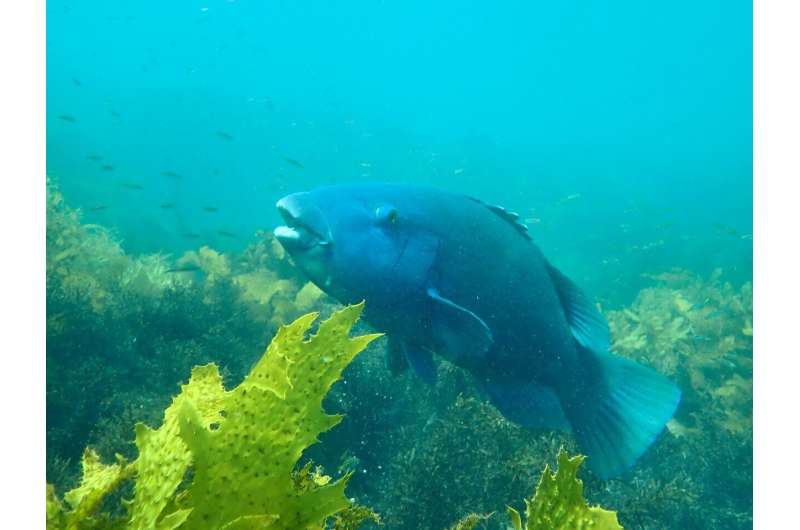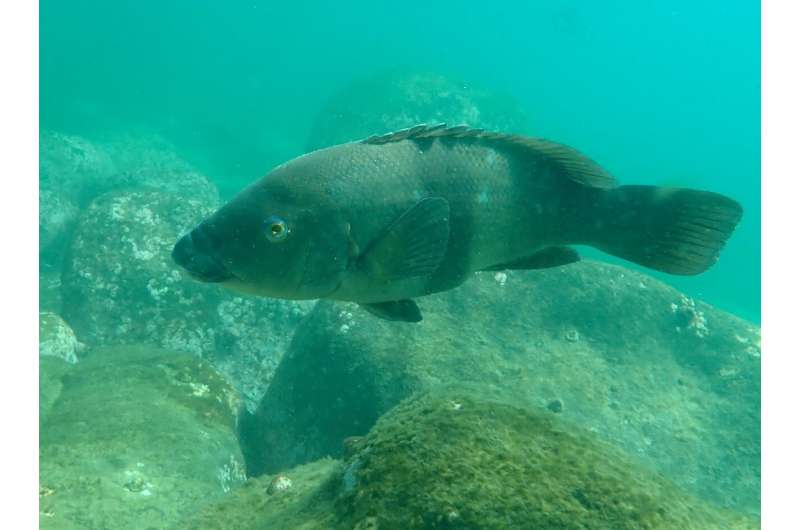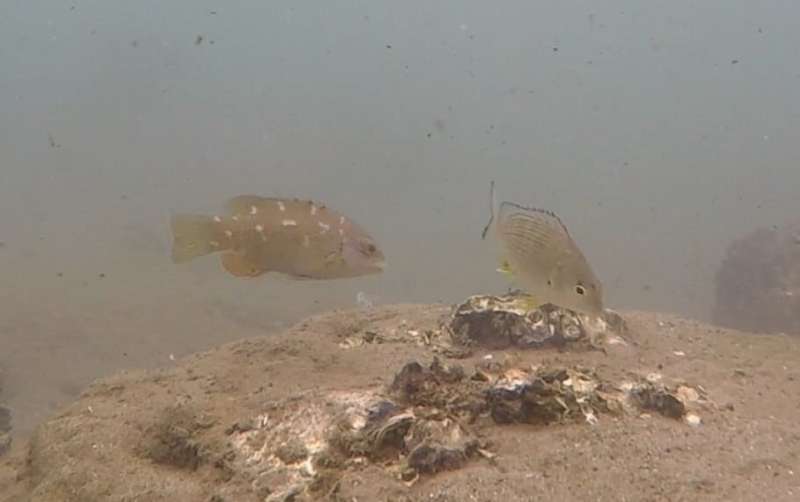Blue gropers recorded on endangered oyster reefs for the first time

Juvenile eastern blue gropers ("blue groper"), the state fish of New South Wales, have been recorded living on endangered oyster reefs for the first time.
University of Sydney researchers spotted the juvenile blue gropers in four remnant oyster reefs in NSW, including Bermagui and Crookhaven in south NSW, and Towra Point and Port Hacking in south Sydney. Their study has been published in the journal Ecology.
However, as oyster reefs are critically endangered around NSW, this home of the blue groper is under threat prompting fears for the fish's long-term survival. The groper is listed as "near threatened" by the International Union for Conservation of Nature (IUCN) due to habitat loss and overfishing in the 1900s.
"Gropers are one of the most beloved fish species in all of Eastern Australia by fishermen, divers, and snorkelers due to their friendly nature (which also puts them at risk), and their vibrant blue and pink colors," said lead researcher, Ph.D. candidate Christopher Pine, from the Faculty of Science.
"Our findings show that oyster reefs are so important for this fish and other fish communities—it highlights the need to protect and restore these threatened systems.
"The loss of this species would be devastating, not just for ecosystems but for the public at large."
Over the past 100 years, humans, along with human-induced climate change, have caused the destruction of nearly 85% of oyster reefs worldwide. In Australia, oyster reefs formed from two native oyster species, the Sydney rock oyster and the southern mud oyster, are considered functionally extinct.
Oyster reefs are impacted by warming waters and ocean acidification due to climate change, along with eutrophication, which is a buildup of nutrients like phosphorus and nitrogen from agricultural and industrial runoff.

The study
The researchers observed the juvenile blue gropers as part of a broader study of fish communities, using underwater video cameras at the four specified NSW oyster reefs. Using these videos, the researchers were able to assess and estimate the abundance, richness and diversity of a variety of fish species at each of the sites.
Juvenile blue gropers were among some of the most abundant fish observed during summer, appearing in nearly 30% of videos taken during the summer of 2021. At Bermagui and Crookhaven, this proportion rose to 56% and 65% respectively.
"The high numbers and frequency of occurrence make it clear that the gropers didn't simply stray into these environments—they chose them, for what exact reason we do not yet know," Mr. Pine said.
"The remnant reefs where the blue gropers were spotted are potentially acting as a nursery, providing protection from predators and wave energy, in addition to providing food such as small crabs, gastropods and worms, which live on and around the oyster shells.
"Juvenile fish often stay in nursery habitats until they grow to adult size. As juveniles, they face an extreme pressure to grow quickly in order to survive, and nursery habitats often provide the perfect place for them to do so.
"That's why protecting and restoring potential fish nurseries and other fish habitats, such as oyster reefs, seagrass meadows and mangrove forests, is so important.
"It's clear that to ensure the groper remains a living emblem and not a relic, efforts to maintain and restore oyster reefs must continue."

About the eastern blue groper
Eastern blue gropers are hermaphrodites—they begin their lives as females and are initially a pinky-brown color. After becoming sexually mature, they transition to the male sex and take on their iconic blue color.
They are found around rocky headlands, coastal reefs, and within estuarine habitats from southern Queensland to eastern Victoria.
Eastern blue gropers are renowned for being extremely curious; coming up to divers and snorkellers to investigate and see what is going on. This curious nature played a role as to why they were overfished in the 1900s, as they would often come right up to the speargun to investigate, leading to their demise.
More information: Christopher Pine et al, Observation of juvenile Eastern Blue Groper ( Achoerodus viridis ) on remnant oyster reefs in New South Wales, Australia, Ecology (2022). DOI: 10.1002/ecy.3824
Journal information: Ecology
Provided by University of Sydney





















